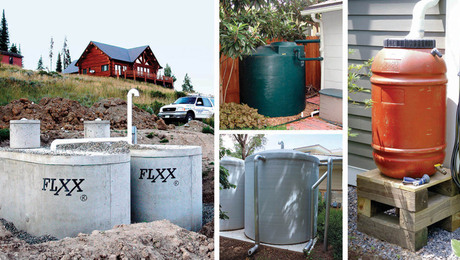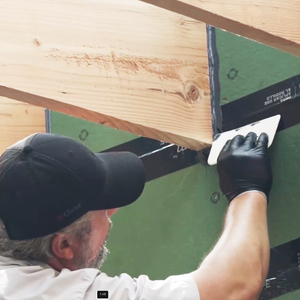Looking for ideas other than conventional plastic vents for new home w/ crawlspace, traditional “american clasic” design. Thought about PT lumber, make my own but trying to avoid PT poison and wood in general. Maybe use 2x material as “form” , remove from pour and grout screen in later- sounds a bit labor intensive. What kind of screen- 1/4″ galv? copper? stainless? Any higher quality passive vents out there or ideas for making them appreciated.
Discussion Forum
Discussion Forum
Up Next
Video Shorts
Featured Story

There's a constant source of clean water for you to use, and all you have to do is collect it.
Highlights
"I have learned so much thanks to the searchable articles on the FHB website. I can confidently say that I expect to be a life-long subscriber." - M.K.

















Replies
My suggestion would be no vents - Make sure you keep water out of the crawl space, and leave a duct open from your HVAC system in the crawlspace. That will keep your crawlspace in good shape.
For sale: complete set of Encyclopedias. Excellent condition. No longer needed. Got married - Wife knows everything.
Don't forget the vapor barrier on the floor, Boss. ITA.Andy Engel, The Accidental Forum moderator
Hi Andy. There wasa significant amount of coverage o this subject in the old archieves.Too bad they are no longer available.
Slope ground around foundation 6 inches in ten feet. Keep shrubs, bushes, flower beds a minimum of 2 feet awawy from foundation. keep, down spout water flow two feet away from foundation.
Cover ground in crawl space with 6 mil polyethylene VDR. Run it up the sides of the foundation walls and secure it to the foundation walls with PT? 1x3. FORGET the vents. They cause the very problem they are alleged to solve. GeneL
Hi Andy. Too bad the old archives are no longer available. There is a lot of discussion on this subject in them.
Slope grade aroud foundation 5%-6 inches in ten feet. Keep all flowe beds, shrubs, bushes a minimum of 2 feet away from the foundation. Keep,down spout discharge three feet awa from foundation.
Cover crawl space ground with 6-milk, VDR (Vapor diffusion retarder). Run it up the sides of the foundation and secure itot the foundation wall witha PT 1x3. CLOSE or do not instll vents. They case the problem they are supposed to solve. GeneL.
All the building codes I'm familiar with require crawl space ventilation, whether they work or not. Better check first. When you discover they are required, try to locate them near corners and on opposite sides for cross ventilation. This eliminates dead air pockets.
The question was about material. If you are in a seasonal climate, it's nice to have operable vents so you can close them in winter, something screens don't offer.
If you condition your crawlspace, that is, treat it as a short basement with a slab on grade, proper drainage, required insulation and maybe HVAC, most building codes don't require crawlspace venting. FWIW, the first person I ever met who doubted the effectiveness of crawlspace venting was a construction official. There are places I can imagine venting working, but none of them have hot, humid summers or winters that require heating the house. Andy Engel, The Accidental Forum moderator
Sounds like this subject has been beaten to death once before so I apologize raising it again.
What is the purpose of the vents? Been told that their intended to vent radon gas (even though radon is essentially non-existent in our area). I too would like to avoid using vents because we hope to incorporate a raised concrete (i.e. zero-maintenance) porch that will block the vents.
The purpose is ostensibly to prevent moisture from building up. However, since crawlspaces tend to be cooler than the outside air, humid summer air brought in for ventilation can actually condense and have the opposite of the intended effect. Add to that the fact that crawlspaces are common in the air-conditioned south, and the floor of an air-conditioned house can serve as a great condensing surface, and you can see the problem.
However, soil below a crawlspace can produce lots of moisture that must be dealt with. That was the original problem venting was hoped to cure. Now, we've got good plastic sub-slab vapor barriers that address this issue.
So, if I were building a crawlspace, I'd put poly on the ground, pour a slab, add no vents and condition the space. If the inspector required vents, I'd foam them shut as soon as I saw his tailights.
I'm not sure how I'd handle it in a dry climate. It probably wouldn't matter.Andy Engel, The Accidental Forum moderator
Andy
I am no expert on this. In fact I am neither a builder or a homeowner with a crawlspace.
But I think that a critical term is being left out in this discusion.
I believe that code does require the area to be vented.
The question is EXTERNAL vents.
That a properly down conditioned crawlspace is vent, but vented to the interior. Which again make sense if you thing about a basement.
And if anyone has concerns about radion they can install collection pipes under the rat slab and later pipe them outside if needed.
Again if this was treated "just like a basement" there should not be any problems.
The purpose of venting by definition is to move air. Think of it this way: the stale, stagnant air in the crawlspace is close to 100% relative humidity. Under these conditions all sorts of nasty things start growing on wood framing, insulation, wet surfaces in general, and start the process with the unfortunate misnomer of "dry rot". (Picture a closed refrigerator with the power off and half a ham sandwich for a few days... I'd rather not.)
Now when you add foundation vents, i.e. open the refrigerator door a little, the nasty stuff escapes as the air changes. The relative humidity will never get higher than it started, and will likely reduce somewhat, hopefully below that required to sustain the critters causing dry rot.
Concrete slab? Why not just slap an inch or two of sand on the poly? And while you're at it, toss that ham sandwich...
Sand's OK I guess, as long as you don't need to access the space often.
How did the humidity get in the crawlspace in the first place? With a sound vapor barrier on the floor, it's not coming from the ground. With good drainage, it's not coming in the walls. What happens when you take 90 degree outside air that's, for example, at 90% humidity, and bring it into, say, a 70 degree crawlspace through your vents? I can assure that this air will not help to dry anything. It will in fact condense, adding to the crawlspace's moisture load. I don't think these imaginary conditions are at all unusual throughout much of the country.
For an explanation of RH and temp, go here:
http://hyperphysics.phy-astr.gsu.edu/hbase/kinetic/relhum.html#c2 Andy Engel, The Accidental Forum moderator
Brucemaser,
As Andy pointed out, it is quite common for a crawlspace vent, in the summer, to introduce warm humid air to a crawlspace. The reason this can cause problems is that the crawlspace is colder than outdoors; with cold surfaces, the hot humid outdoor air has somewhere to condense. Result: liquid water. This happens all the time. Some people refer to the problem as "a raining crawlspace" -- when you enter, the water drips off the joists onto your head.
Moreover, you don't want sand on the poly. Sand absorbs moisture, so why put a sponge on the poly? Once it becomes wet, it is a reservoir to hold moisture where you don't want it.
We are currently working on a timber frame addition, been in place for well over 100 years I bet. Sills were rotted because of a concrete pad poured against the house. Replaced the sills, gutted the entire addition, (16 x 22), dug the crawlspace a bit deeper by a few inches, leveled it out, put 6 mil poly down and then poured a rat slab over the whole works. Still feel it's best to put vents in so we made up two 8 x 18 vents with 5/4 mahogany, brass screen attatched in the interior, steel bars on 4" centers vertically, sloped to keep water running off the window sill, and a cedar cover that slips inside the frame, against the bars, and brass slides to hold it in place for the winter. This is a period home so steel windows just wouldn't do. They look pretty good surrounded by the foundation granite. The only glitch I see is getting the homeowners to understand that they have to put on and take off the covers. It's interesting to read the other responses and I'll have to keep checking in on this place in the next few seasons to see what develops.
Rod